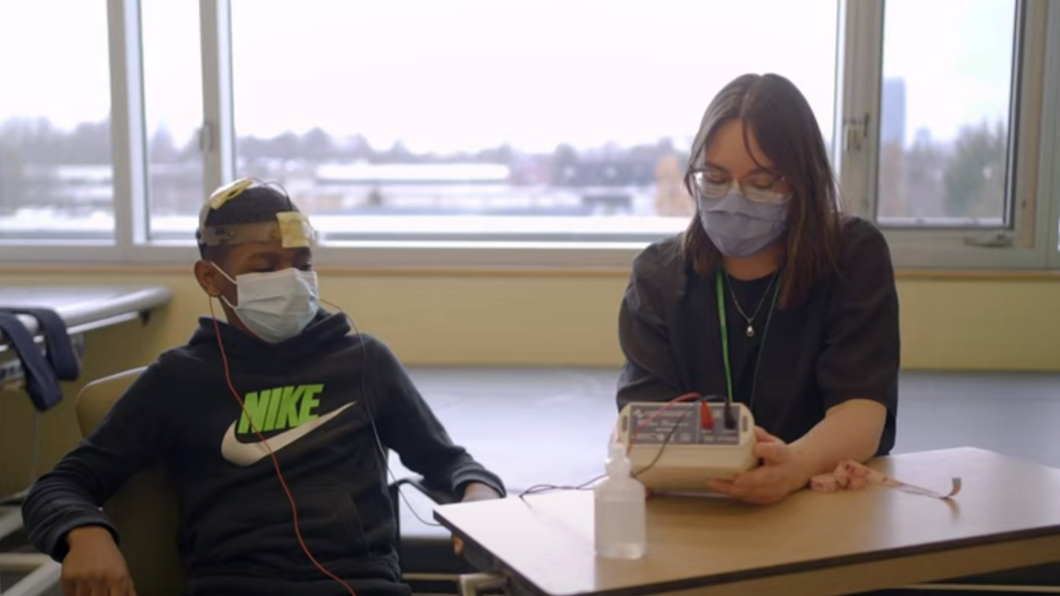
How one lab is researching how neuromodulation treatments are enhancing therapy outcomes for clients
Our brains are complex organs that scientists are always learning more about.
At Bloorview Research Institute’s CONNECT Lab, a research team led by Dr. Deryk Beal is committed to understanding neurodevelopmental diversity and finding regions of the brain that are important for kids’ rehabilitation.
The team is using novel, specialized neuromodulation equipment to enhance speech-language rehabilitation for children who have had a stroke or brain injury, to help clients with ASD regulate their emotions and behaviours, and to maximize physiotherapy outcomes. Neuromodulation can act as a standalone therapy or augment therapies that kids are already receiving, allowing rehabilitation to be even more impactful. It’s just one of the many examples within the BRI of how research impacts real-life therapies and solutions.
One type of neuromodulation research equipment used by the team is the transcranial magnetic stimulation system (TMS). Housed in the institute’s Neuromodulation Discovery Hub, this system is a magnetically induced electrical stimulation that can increase or decrease brain activity in specific areas of the brain.
Another type of research equipment used by the CONNECT team, and also housed in the discovery hub, is the transcranial direct current stimulation (tDCS) to alter brain activity in a more natural environment, such as in the physiotherapy gym right before a client’s scheduled therapy.
For D’Andre, an outpatient client at Holland Bloorview, participating in neuromodulation improved his physiotherapy outcomes and his mobility. He was also excited to come to the research institute because he could watch Netflix shows on the lab’s TV during treatment! His mom, Kristle, says: “Our experience with neuromodulation was awesome. D’Andre was happy to be part of the neuromodulation experience, and I got to see how effective it was. Even though he didn’t want to do it at first, he got hold of it, and that made him excited to come. He was a different person after the treatment—active, and willing to do his activities in physio.”
Kids and families get to be involved in the understanding of how this technology impacts their brains. Kristle was amazed by how the scientists could target specific areas of D’Andre’s brain. Trina Mitchell, research coordinator at the CONNECT Lab, states, “this research environment at Holland Bloorview has made me realize that everyone’s brain is different, and the kids we have seen are really interested in how their brain works and how we can influence what the brain does.” Holland Bloorview is committed to co-creating research and novel treatments with clients and families, and the CONNECT Lab is no exception. Trina explains that clients and families have informed her work—they push for novel treatments and interventions, they provide feedback to make treatments and resources accessible and relevant, and they inspire the future.
Parents like Kristle are committed to ensuring others know about this important research.
“Research is the key to making resources available. Without research, there would not be a way to help others. Neuromodulation is a steppingstone to help children get better physically and mentally, and when done in an inclusive environment, it is so effective.”
Through collaborating with various teams at Holland Bloorview, including the Brain Injury Rehabilitation Team (BIRT), the MRI suite, the SPARK (Supporting Physical Activity-based rehabilitation Research for Kids) Lab, and POND (Province of Ontario Neurodevelopmental Network), the lab’s research and treatments are exceptionally enhanced.
Holland Bloorview is one of only a few hospitals in Canada to offer neuromodulation therapies in a pediatric friendly and accessible environment. To make neuromodulation treatments more accessible for families, the team is working on implementing findings in different communities through a take home-based system of transcranial direction stimulation (tDCS). This is a direct result of input from families such as Kristle’s: “I hope this technology will become accessible for all, because it has worked in my son’s favour.”
The future of this technology is bright and hopeful.
Watch this video to learn more about neuromodulation and see D’Andre in action! https://www.youtube.com/watch?v=Z0VFDP-6LiY